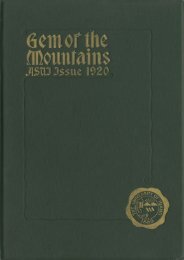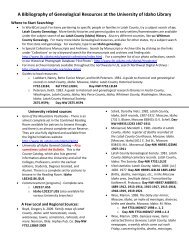Download PDF - University of Idaho Library
Download PDF - University of Idaho Library
Download PDF - University of Idaho Library
Create successful ePaper yourself
Turn your PDF publications into a flip-book with our unique Google optimized e-Paper software.
The forgotten legacies<br />
Reminders <strong>of</strong> the past are scattered across campus<br />
Gone. They're all gone. Most <strong>of</strong> those who<br />
have given to the university have died.<br />
The rest simply faded from our<br />
memories, but what haven't faded are the gifts<br />
they left behind. Scattered across campus are<br />
monuments <strong>of</strong> friendship, good fai th, and<br />
gratitude. In the forms <strong>of</strong> plaques, trees,<br />
exhibits or museums, the gifts are to be appreciated<br />
and enjoyed.<br />
The most obvious are the commemorative<br />
trees planted by visiting dignitaries on the Ad<br />
Lawn. When strolling through the tall trees,<br />
students can read the plaques that note the<br />
benefactor, the date and the type <strong>of</strong> tree.<br />
Even though <strong>Idaho</strong> is a small university,<br />
some very prominent people have visited<br />
campus. In the past 93 years, President<br />
Theodore Roosevelt, President William Taft,<br />
U.S. Senator Frank Church and Eleanor<br />
Roosevelt have visited campus and planted<br />
trees, which now provide a beautiful setting<br />
for the Ad Building.<br />
With a little curiosity and climbing, the Jack O'Connor<br />
Wildlife Collection and the Department <strong>of</strong> Biological Science's<br />
Natural History Museum can both be explored on the third<br />
floor <strong>of</strong> the Life Science Building.<br />
The O'Connor collection features 50 animal specimens from<br />
Africa and North America.<br />
Just <strong>of</strong>f to the side <strong>of</strong> the O'Connor collection is the Audubon<br />
Room containing prints, books, paintings, portraits and<br />
aquatints. This collection was donated by Earl Larrison,<br />
associate pr<strong>of</strong>essor <strong>of</strong> Zoology.<br />
Out <strong>of</strong> sight.<br />
In the Ad Building tower are<br />
the speakers for the David<br />
Memorial Carillon which<br />
consist <strong>of</strong> 183 bell units.<br />
(photo by J. Yost)<br />
With more curiosity and a little less climbing,<br />
the UI Museum can be found on the<br />
second floor <strong>of</strong> the Faculty Office Complex<br />
West. The museum was started in 1964 by a<br />
faculty committee and the academic vice<br />
president. All <strong>of</strong> the several thousand pieces<br />
in the collection have been donated by<br />
faculty, students, alumni, townspeople and<br />
organizations.<br />
Some <strong>of</strong> the major collections <strong>of</strong> the museum<br />
are the African exhibit, which is one <strong>of</strong> the<br />
finest in the Northwest, even rivaling that <strong>of</strong><br />
the Seattle Art Museum. Another is the Arab<br />
collection which represents twelve Middle<br />
East countries, and features the finest display<br />
<strong>of</strong> Arabian dress in the western United States.<br />
Although the museum has many outstanding<br />
exhibits, it serves another purpose.<br />
For the last sixteen years, the museum has<br />
also been used for museum studies.<br />
The most ellusive <strong>of</strong> the gifts is the David<br />
Memorial Carillon, which was presented to the university by<br />
the Davids' five children, all UI graduates, in memory <strong>of</strong> Mr.<br />
and Mrs. Frank David. The Davids, who founded David's<br />
Department Store, came to Moscow in 1889, the same year the<br />
university was founded. The Carillon consists <strong>of</strong> 183 small<br />
bronze bell units. The bell vibrations are picked up electronically,<br />
amplified more than a million times and<br />
reproduced from speakers in the tower <strong>of</strong> the Ad Building.<br />
Although some <strong>of</strong> the gifts have been forgotten, they remind<br />
us <strong>of</strong> the university's unique and colorful history. D<br />
All scrolled up.<br />
The David Memorial Carrillon<br />
bells and control console are kept<br />
in an extra room in the Music<br />
Building. Jackie Roelen, senior<br />
secretary at the School <strong>of</strong> Music.<br />
changes the music scroll (photo by<br />
P.Jerome)<br />
An "old"lady.<br />
Portrait DeFemme. by Jean Raoux<br />
{1677-1734) is one <strong>of</strong> the thousands<br />
<strong>of</strong> pieces ln the UI Museum. Raoux.<br />
whose works are exhibited all over<br />
the world. won the Prix de Rome.<br />
the forem011t award for an artist. in<br />
1704. (photo P. Jerome)<br />
Forgotten Gifts 111

















